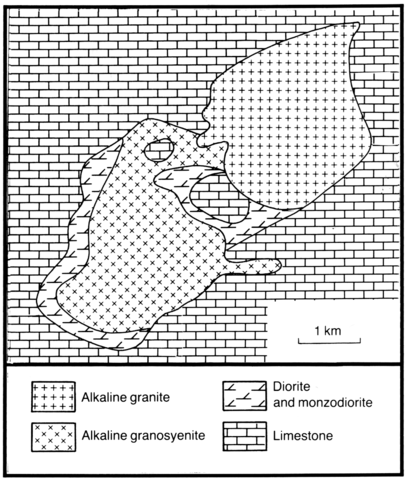stripes
This intrusion is situated in the central part of the Alayski Mountains and occupies an area of about 20 km2. It lies on the northern side of an anticlinorium composed of marbles of Carboniferous age. In the north it breaks through lower Carboniferous schists, conglomerates and sandstones. At the contact with the limestones in places garnet and pyroxene skarns have been produced which contain scheelite. There are numerous satellite intrusions composed of granodiorite, granite and syenite. Four principal groups of rocks make up the intrusion: granosyenites, quartz diorites and monzonites, trachytic subalkaline syenites, alkaline granites and nepheline syenites. The granosyenites are developed in the southern part of the complex and the subalkaline syenites in the central part where they cut granosyenites and are represented by pyroxene-amphibole and biotite-amphibole varieties. The alkaline granites, which are leucocratic rocks, cut the syenites. Nepheline syenites are confined to the southwestern part of the complex where they form dykes up to 15 m in length; their relationship with the subalkaline syenites is not clear. Granite and syenite aplite dykes occur.
KAYUMOV, A.K. and KARABAEV, K.K. 1981. Alkaline magmatism and ore-formation of the south Tyan-Shan. Uzbek Academy of Science Publishers, Tashkent. 135 pp.
SHINKAREV, N.F. 1966. Upper Palaeozoic magmatism of Turkestan-Alay. Leningrad University Publishers, Leningrad. 152 pp.

